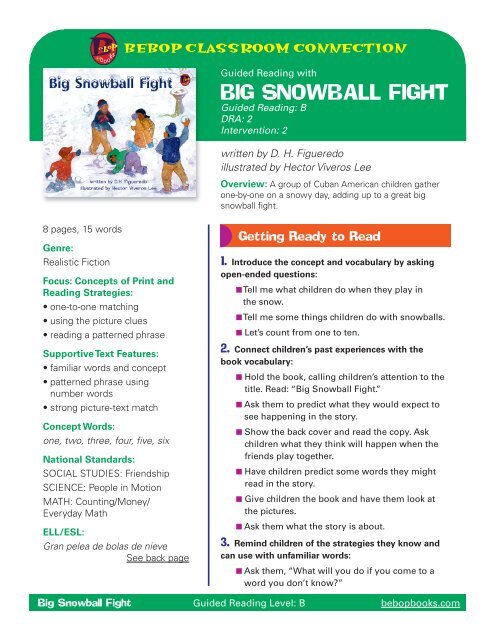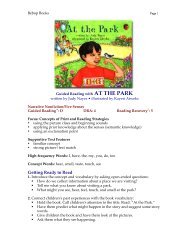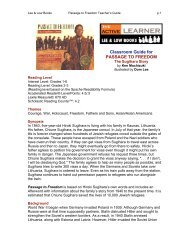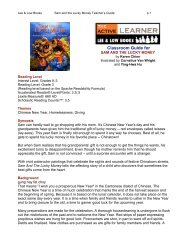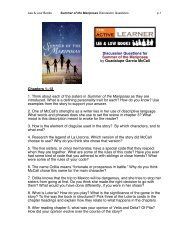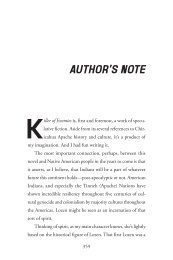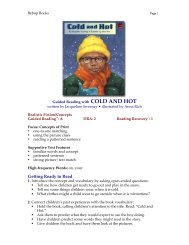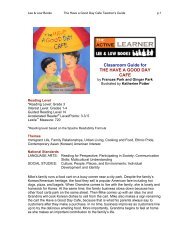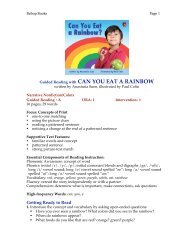Download Lesson Plan in PDF - Lee & Low Books
Download Lesson Plan in PDF - Lee & Low Books
Download Lesson Plan in PDF - Lee & Low Books
Create successful ePaper yourself
Turn your PDF publications into a flip-book with our unique Google optimized e-Paper software.
BEBOP CLASSROOM CONNECTION<br />
Guided Read<strong>in</strong>g with<br />
BIG SNOWBALL FIGHT<br />
Guided Read<strong>in</strong>g: B<br />
DRA: 2<br />
Intervention: 2<br />
written by D. H. Figueredo<br />
illustrated by Hector Viveros <strong>Lee</strong><br />
Overview: A group of Cuban American children gather<br />
one-by-one on a snowy day, add<strong>in</strong>g up to a great big<br />
snowball fight.<br />
8 pages, 15 words<br />
Genre:<br />
Realistic Fiction<br />
Focus: Concepts of Pr<strong>in</strong>t and<br />
Read<strong>in</strong>g Strategies:<br />
• one-to-one match<strong>in</strong>g<br />
• us<strong>in</strong>g the picture clues<br />
• read<strong>in</strong>g a patterned phrase<br />
Supportive Text Features:<br />
• familiar words and concept<br />
• patterned phrase us<strong>in</strong>g<br />
number words<br />
• strong picture-text match<br />
Concept Words:<br />
one, two, three, four, five, six<br />
National Standards:<br />
SOCIAL STUDIES: Friendship<br />
SCIENCE: People <strong>in</strong> Motion<br />
MATH: Count<strong>in</strong>g/Money/<br />
Everyday Math<br />
ELL/ESL:<br />
Gran pelea de bolas de nieve<br />
See back page<br />
Gett<strong>in</strong>g Ready to Read<br />
1. Introduce the concept and vocabulary by ask<strong>in</strong>g<br />
open-ended questions:<br />
■ Tell me what children do when they play <strong>in</strong><br />
the snow.<br />
■ Tell me some th<strong>in</strong>gs children do with snowballs.<br />
■ Let’s count from one to ten.<br />
2. Connect children’s past experiences with the<br />
book vocabulary:<br />
■ Hold the book, call<strong>in</strong>g children’s attention to the<br />
title. Read: “Big Snowball Fight.”<br />
■ Ask them to predict what they would expect to<br />
see happen<strong>in</strong>g <strong>in</strong> the story.<br />
■ Show the back cover and read the copy. Ask<br />
children what they th<strong>in</strong>k will happen when the<br />
friends play together.<br />
■ Have children predict some words they might<br />
read <strong>in</strong> the story.<br />
■ Give children the book and have them look at<br />
the pictures.<br />
■ Ask them what the story is about.<br />
3. Rem<strong>in</strong>d children of the strategies they know and<br />
can use with unfamiliar words:<br />
■ Ask them, “What will you do if you come to a<br />
word you don’t know?”<br />
Big Snowball Fight Guided Read<strong>in</strong>g Level: B bebopbooks.com
BEBOP CLASSROOM CONNECTION<br />
■ Encourage children to look at the pictures<br />
and the beg<strong>in</strong>n<strong>in</strong>g sound of the word.<br />
4. Be aware of the follow<strong>in</strong>g text features:<br />
■ The book conta<strong>in</strong>s number words<br />
■ The book conta<strong>in</strong>s familiar words: big,<br />
snowball, snowballs.<br />
■ There is a patterned phrase:<br />
“one snowball.”<br />
■ Only the number word changes on<br />
each page.<br />
■ The phrase on the last page is different:<br />
“Big Snowball Fight!”<br />
Read<strong>in</strong>g the Book<br />
1. Set a purpose by tell<strong>in</strong>g children to<br />
read the book to f<strong>in</strong>d out how many snowballs<br />
the children made and what they did with<br />
the snowballs.<br />
2. Have children read quietly, but out loud.<br />
Each child should be read<strong>in</strong>g at his or her own<br />
pace. Children should not read <strong>in</strong> chorus. Listen<br />
to children as they read by lean<strong>in</strong>g close or<br />
bend<strong>in</strong>g down beside each child.<br />
3. Look for these read<strong>in</strong>g behaviors dur<strong>in</strong>g the<br />
first read<strong>in</strong>g:<br />
■ Do the words they say match the pr<strong>in</strong>ted<br />
words <strong>in</strong> the book? (voice to pr<strong>in</strong>t match)<br />
■ Do they look at the pictures before they<br />
read the text or after they read?<br />
■ What do they do if they encounter<br />
an unfamiliar word? (appeal to you, try<br />
a strategy)<br />
■ Do their eyes go up to the picture before<br />
read<strong>in</strong>g the new word <strong>in</strong> the pattern?<br />
■ Are they say<strong>in</strong>g the <strong>in</strong>itial sounds of words<br />
before say<strong>in</strong>g the whole word?<br />
■ Are they say<strong>in</strong>g the <strong>in</strong>dividual<br />
letter sounds /o/ - /n/ - /e/ or blend<strong>in</strong>g<br />
the sounds?<br />
■ Do they reread if they come to an<br />
unfamiliar or unknown word?<br />
■ Have they self-corrected any mistakes?<br />
■ Is there any <strong>in</strong>flection or speech-like sound<br />
to their read<strong>in</strong>g?<br />
■ Have they responded with a laugh or<br />
other sound as they read the text?<br />
■ Do they make comments as they read?<br />
4. As children read, suggest a read<strong>in</strong>g strategy<br />
if they are struggl<strong>in</strong>g: “Try look<strong>in</strong>g at the picture<br />
to make sense of the pr<strong>in</strong>t.” Encourage children<br />
to take a guess or count the snowballs.<br />
5. Possible teach<strong>in</strong>g po<strong>in</strong>ts to address based<br />
on your observations:<br />
■ Review us<strong>in</strong>g the picture to help with each<br />
new number word.<br />
■ Review us<strong>in</strong>g the beg<strong>in</strong>n<strong>in</strong>g sound.<br />
■ Model how to reread the phrase if it<br />
doesn’t sound right or make sense.<br />
■ Call attention to the exclamation po<strong>in</strong>t on<br />
the last page.<br />
Big Snowball Fight Guided Read<strong>in</strong>g Level: B bebopbooks.com
BEBOP CLASSROOM CONNECTION<br />
After the First Read<strong>in</strong>g<br />
1. Have children confirm their predictions about<br />
the children’s snowball fight.<br />
2. Ask children to read the last l<strong>in</strong>e of the story<br />
the way children might say it.<br />
3. Discuss how you make snowballs and list<br />
the steps.<br />
4. Reflect on what happened <strong>in</strong> the story. Look<br />
at the last page and generate some words for<br />
each child to say dur<strong>in</strong>g the snowball fight.<br />
5. Discuss the rules children might develop to<br />
make the snowball fight fair and fun.<br />
Second Read<strong>in</strong>g<br />
1. Have children reread the book <strong>in</strong> a whisper<br />
voice or to a partner.<br />
2. This is a time for assessment. While they are<br />
read<strong>in</strong>g, watch what children do and what they<br />
use from the teach<strong>in</strong>g time. Alternatively, you<br />
might take a runn<strong>in</strong>g record on one child as an<br />
assessment of the child’s read<strong>in</strong>g behavior.<br />
Cross-Curricular Activities<br />
Language: Play with s<strong>in</strong>gular and plural<br />
nouns: one snowball, three snowballs; one cat,<br />
five cats; one child, six children; one mouse, two<br />
mice; and so on.<br />
Art: Read EMMETT’S SNOWBALL by Ned<br />
Smith and the have children pa<strong>in</strong>t pictures of<br />
the “biggest” snowball <strong>in</strong> the world. Add details<br />
to the picture with markers or crayons. Who<br />
made the biggest snowball <strong>in</strong> the picture?<br />
Science: If there is snow where you live, have<br />
children make snowballs and br<strong>in</strong>g them <strong>in</strong>side<br />
to watch them melt. Record what happens over<br />
the course of an hour or the day.<br />
Math: Practice count<strong>in</strong>g objects. Show children<br />
cards with different objects. Count the objects<br />
and then choose the correct number word.<br />
Make a center activity <strong>in</strong> which children use<br />
rubber stamps to make one, two, three, four,<br />
five, six objects and then have them write the<br />
number and the number word under each set.<br />
Social Studies: Discuss why schools have<br />
a “no snowball fight” rule. How might children<br />
conv<strong>in</strong>ce the teachers and pr<strong>in</strong>cipal to allow<br />
snowball mak<strong>in</strong>g and throw<strong>in</strong>g?<br />
Writ<strong>in</strong>g: Write a story about throw<strong>in</strong>g<br />
snowballs or about a snowball fight.<br />
Big Snowball Fight Guided Read<strong>in</strong>g Level: B bebopbooks.com
BEBOP CLASSROOM CONNECTION<br />
Guided Read<strong>in</strong>g with<br />
GRAN PELEA DE<br />
BOLAS DE NIEVE<br />
Guided Read<strong>in</strong>g: A<br />
EDL/DRA: 1<br />
Intervention: 1<br />
The Spanish edition also uses a patterned phrase<br />
and number words: uno, dos, tres, cuatro, c<strong>in</strong>co, seis.<br />
Because many children speak dialects or may mix<br />
Spanish and English, you may have to help them<br />
understand that “book language” does not always match<br />
the words we use every day.<br />
The book <strong>in</strong>troduction and guided read<strong>in</strong>g lesson follow<br />
the outl<strong>in</strong>e for the English edition. Children need exactly<br />
the same support and strategy <strong>in</strong>struction as their<br />
English-speak<strong>in</strong>g classmates.<br />
If children have difficulty with the concepts or words <strong>in</strong><br />
the story, see the article “Guided Read<strong>in</strong>g with Emergent<br />
Readers” for suggestions.<br />
For more <strong>in</strong>formation about Bebop <strong>Books</strong>, please contact:<br />
Craig <strong>Low</strong>, Publisher<br />
Bebop <strong>Books</strong><br />
An impr<strong>in</strong>t of LEE & LOW BOOKS<br />
95 Madison Avenue<br />
New York, NY 10016<br />
212-779-4400 x. 26 ph.<br />
212-683-1894 fax<br />
clow@bebopbooks.com<br />
Guided Read<strong>in</strong>g Guided read<strong>in</strong>g levels were assigned by literacy experts and certified Read<strong>in</strong>g Recovery ® teachers us<strong>in</strong>g the guidel<strong>in</strong>es identified <strong>in</strong> Guided Read<strong>in</strong>g and Match<strong>in</strong>g <strong>Books</strong> to Readers by<br />
Irene C. Fountas and Gay Su P<strong>in</strong>nell.<br />
INT. (Intervention) Intervention levels were assigned by literacy experts and certified Read<strong>in</strong>g Recovery ® teachers and are <strong>in</strong>tended for use <strong>in</strong> early <strong>in</strong>tervention and one-on-one tutorial programs, <strong>in</strong>clud<strong>in</strong>g<br />
Read<strong>in</strong>g Recovery ® . These levels are not officially authorized by Read<strong>in</strong>g Recovery ® . Read<strong>in</strong>g Recovery ® is a registered servicemark of The Ohio State University.<br />
DRA (Developmental Read<strong>in</strong>g Assessment) and EDL (Evaluación del desarrollo de la lectura) DRA and EDL levels were determ<strong>in</strong>ed us<strong>in</strong>g <strong>in</strong>formation <strong>in</strong> the Developmental Read<strong>in</strong>g Assessment<br />
Resource Guide and EDL Resource Guide by Joetta Beaver.<br />
All level placements may vary and are subject to revision. Teachers may adjust the assigned levels <strong>in</strong> accordance with their own evaluations.<br />
Copyright © 2002 by Bebop <strong>Books</strong> ® , an impr<strong>in</strong>t of <strong>Lee</strong> & <strong>Low</strong> <strong>Books</strong> Inc. Used with permission.<br />
$5.00<br />
item #: LP8522<br />
Gran pelea de bolas de nieve Guided Read<strong>in</strong>g Level: A bebopbooks.com


